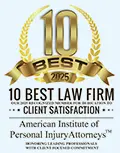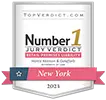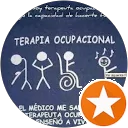In New York City, navigating the aftermath of a workplace accident can be daunting, especially when injuries result from third-party negligence. While workers’ compensation may offer some relief, it often falls short of covering the full extent of damages incurred. This is where Harris, Keenan & Goldfarb steps in. Our team of dedicated New York City Workplace Injury Lawyers and personal injury lawyers specializes in pursuing third-party negligence lawsuits to secure the comprehensive compensation our clients deserve.
Beyond the limited scope of workers’ compensation, we focus on identifying and holding accountable those third parties whose negligence has led to serious injury caused by a workplace accident. Whether you’re facing injuries from an office environment or a construction site accident, Harris, Keenan & Goldfarb is committed to fighting for your rights, ensuring you receive full compensation for your injuries, lost wages, and suffering, enabling you to focus on your recovery and rebuild your life.
Understanding New York’s Workers’ Compensation Laws
In New York, workers’ compensation benefits are designed to provide support and financial assistance to injured workers. The system covers medical expenses and a portion of lost wages for those unable to work due to their injuries, including a wide range of workers’ compensation benefits such as medical benefits and compensation for lost wages. However, navigating the workers’ compensation system can be complex.
The New York Workers Compensation Board plays a crucial role in this process, overseeing the filing of claims, the appeals process, and ensuring injured workers obtain the benefits they are entitled to. The process is fraught with challenges, from filing claims to understanding what’s covered, dealing with potential denials, and navigating the appeals process with the Workers Compensation Board.
Additionally, if your injury was caused by a third party’s negligence, you might have the option to pursue a personal injury lawsuit for damages not covered by workers’ compensation, such as pain and suffering.
Why Choose a Workplace Injury Lawyer from Harris, Keenan & Goldfarb in New York City
At Harris, Keenan & Goldfarb, our track record of success in handling workplace accident and injury cases sets us apart. Our team of dedicated workers’ compensation attorneys possesses in-depth knowledge of New York’s workers’ compensation laws and the intricacies of personal injury litigation.
We’re committed to advocating for your rights as workers’ compensation lawyers, ensuring you receive the maximum compensation available, and guiding you through every step of the legal process. Our expertise extends to a wide range of workplace injuries, from construction accidents to office-related illnesses, ensuring tailored legal strategies for each client.
Secure Your Future with a Free Case Review from a Harris, Keenan & Goldfarb New York City Workplace Injury Lawyer
If you or a loved one has suffered a workplace injury in New York City, don’t navigate the complex legal landscape alone. Contact the experienced New York City Workplace Injury Lawyers at Harris, Keenan & Goldfarb for a free consultation. We’re here to assess your case, advise on the best course of action, and represent your interests, ensuring you receive the compensation you deserve.
Our firm is dedicated to helping clients secure the full financial compensation they deserve for medical care, lost income, and other expenses incurred from workplace injuries. Call us today at to start the process of securing your future.














































